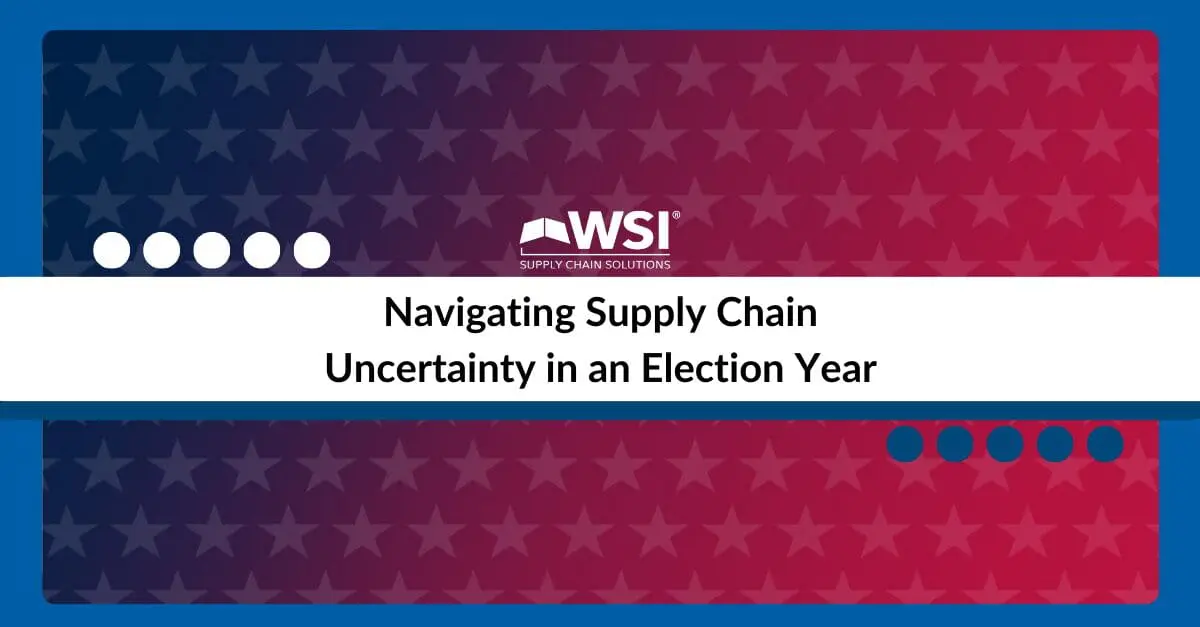Navigating Supply Chain Uncertainty in an Election Year
How American 3PLs Support Supply Chain Resilience
Presidential campaigns are focusing on trade policies which are expected to have a major impact on American manufacturers and supply chains.
The stakes are always high in U.S. presidential elections with their outcome affecting trade policies and business. But the 2024 election signals greater changes and uncertainty ahead for supply chains worldwide involving the cost and flow of goods imported and exported from the U.S.
Front and center are tariffs on U.S. imports which play an increasingly larger role in both long-term and short-term supply chain strategies for manufacturing and sourcing. While the U.S. Congress is vested with trade authority, this responsibility has been largely delegated to the president in recent administrations.
Before we look at the potential outcomes of the election on U.S. supply chains, here’s a recap of current trade policies.
Trade policy in the spotlight
Many companies with U.S. operations were already reducing their reliance on products made in China as a result of the broad tariffs on China imposed in 2018 and extended in the following years.
In recent years, many U.S. manufacturers and retailers have reduced dependence on China as production continues to shift to other low-wage countries such as Mexico, , and India. In some cases, Chinese firms have shifted production abroad to avoid U.S. tariffs and take advantage of reduced or zero tariffs under free trade agreements, such as the U.S.-Mexico-Canada Agreement.
As of 2023, Mexico is now the U.S.’s largest trading partner and the leading source of goods imported in the U.S., followed by Canada and then China (which has fallen from its top spot in recent years), giving insight into the magnitude of the production shifts that have changed trade patterns worldwide as a result of trade policies. In turn, new trade restrictions are instituted to combat loopholes, such as tariff restrictions to help circumvent the back-door steel from China that enters the U.S. through Mexico.

Impact of new trade policies on supply chains
Regardless of which new administration takes over in January 2025, trade policies will have significant implications for supply chains. Trade policies by both parties de-emphasize trade with China as a geopolitical and economic rival. Both also call for a stronger U.S. industrial base to shape the economy through targeted measures on specific domestic industries with the intent to revive American manufacturing and create new jobs.
With either party that takes office in 2025, U.S. importers in particular can expect to make changes to their supply chain strategies in the face of China trade policies which will tighten further. Production and trade patterns will continue to shift as a result of new trade policies, having a trickle-down effect on many U.S. shippers and 3PLs. Stiff tariffs and retaliatory measures could also thwart competition abroad on U.S. exports, making American-made goods sold abroad more expensive.
Strategies to prepare for restrictive trade
Many large companies and U.S. importers have already been shifting their global supply networks as a result of the multi-year disruptions from the global pandemic and the heavy tariffs with China that started Others are accelerating the shift given greater economic and geopolitical uncertainty in the face of a more restrictive global trade environment.
Short-Term Strategies
Some companies with a U.S. presence are holding off on expansion and investment plans given the uncertainty over tariffs on imported parts and products, and others are taking a wait-and-see approach until after the November 2024 election.
In the short term, some U.S. companies are stockpiling inventory by increasing imports which has already set off early port congestion in advance of the 2024 peak shipping season as retailers amass inventory for the holiday season.
When tariffs are implemented, instituting price increases to customers, asking suppliers to make concessions, and benefitting from foreign exchange (known as FX) rates. Exchange rates tend to move in a way that offsets the impact of tariffs. For example, a tariff on U.S. imports can cause the U.S. dollar (as the home currency) to appreciate. Likewise, a tariff on exports can cause the home currency to depreciate.
Long-Term Strategies
Many companies have already moved to multi-sourcing strategies, relying on multiple suppliers and manufacturing locations to mitigate risk and reduce supply chain uncertainty. Longer-tail strategies to counter trade restrictions include diversifying supplier bases to include suppliers in countries with fewer tariff restrictions and those that are closer to home.
Of course, reshoring and offshoring are long-term strategies. Reshoring, the process of establishing production centers in the U.S., can take years and labor costs often don’t make it a viable option unless government incentives are available as seen recently with the semiconductor and EV industries. But for other sectors, the lure of reduced labor costs from automation, including robotics, AI, and other technologies as well as reduced logistics costs from domestic manufacturing can make U.S.-made more attractive. Nearshoring or close relocation in Mexico or other nearby countries still takes time and investment to establish.
Regionalization is another strategy as practiced by U.S. automakers that source components in one region such as in Mexico and assemble in the U.S., minimizing transportation costs and trade risks.
Exporters and importers also are increasing their use of 3PLs and forming close partnerships, according to 2024 28th Annual 3PL Study, a report that surveys 3PLs and shippers worldwide. Both shippers (at 62 percent) and 3PLs (at 87 percent) surveyed said shippers have increased the use of outsourced logistics over the prior year. At the same time, more shippers reported reducing or consolidating their use of 3PLs than the prior year.
It might be no surprise the top services outsourced by shippers are warehousing, domestic transportation, customs brokerage, and transportation planning and management, according to the 28th Annual 3PL Study.
The Role of 3PLs in Navigating Restrictive Trade
Partnering with a U.S.-based 3PL in a restrictive trade environment offers valuable benefits, including increased control, reduced risk, and greater supply chain flexibility and resilience.
Importers and exporters can seek the duty management expertise of American 3PLs that provide customs house brokerage and international freight forwarding services. These logistics providers often have expertise in navigating complex tariff structures and identifying opportunities for tariff reductions.
When companies need to consider sourcing new suppliers because of tariffs on U.S. imports and other trade restrictions, U.S. 3PLs have access to vast networks and can help to identify alternative suppliers, both domestic and international, reducing reliance on any single country or region.
U.S.-based 3PLs also can help shippers develop a more regionalized supply chain from not only the inventory, warehousing and distribution perspectives but for those with U.S. production or are considering it, 3PLs can also coordinate U.S. assembly and manufacturing across regions. This means shortened lead times, and minimized transportation costs and trade risks.
In summary, supply chains are faced with greater uncertainty in this election year, one already rife with economic woes and disruptions. Once a new administration takes the reigns in 2025, inevitable shifts to global supply chains will continue in the face of trade restrictions. Contingency planning, cost control and a continued eye on innovation to increase efficiencies is paramount for shippers and their 3PLs.

About the Author

Rich Reba
Rich Reba is a seasoned marketing professional with 15+ years of collective experience. Rich started his career in the finance realm, working for companies including Merrill Lynch, AXA Advisors, Vanguard Dealer Services, and Summit Financial Resources, where he held sales support, analyst, and marketing positions. Since 2015, Rich has led the marketing efforts for a beauty-focused ecommerce 3PL, a direct response Skincare brand, and a national recognized logistics provider. Currently, he directs the WSI marketing program, writing on topics that interest him within the space.



